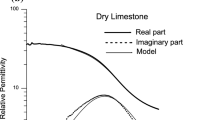Abstract
Hydraulic permeability is one of the most important parameters for the evaluation of sediments relevant to environmental and hydrogeological problems. Up to now, permeability could be determined only by time-consuming and expensive methods like pumping tests or sampling and laboratory investigations. The results are confined to few locations, and they depend on the scale of the investigation method. Measurements on rock samples in a laboratory can differ significantly from well test results. Geophysical measurements are performed on different scales from high resolution measurements in boreholes up to large-scale soundings. Variations in permeability are mainly caused by varying grain size and by changes in porosity. A decrease of average grain diameter results in an increasing internal surface area. Petrophysical investigations have shown a reliable correlation between the imaginary part of electrical conductivity and the porespace-related internal surface. The formation resistivity factor, which is related to porosity, can be determined by geoelectrical measurements if the electrical conductivity of the pore fluid is known. The internal surface area and the formation factor are the only two parameters used by a Kozeny-Carman-like equation to evaluate the permeability or hydraulic conductivity for the investigated representative volume. Complex electrical conductivity is determined by measurements of induced polarization in the frequency domain. Frequencies below 10 Hz are used to avoid electromagnetic coupling. The permeability values determined by electrical measurements in boreholes can well be compared with those derived from the grain size distribution of samples. The same algorithm can be applied to evaluate the hydraulic conductivity of subsurface layers by complex resistivity soundings. The high sensitivity of the imaginary conductivity component to changes at the internal surface may be used as an indicator for contaminations.
Similar content being viewed by others
References
Börner F (1992) Complex conductivity measurements of reservoir properties. In: Worthington PF (Ed), Advances in core evaluation III-reservoir management. Reading: Gordon and Breach Science Publishers. pp 359–386
Börner F and Schön J (1991) A relation between the quadrature component of electrical conductivity and the surface area of sedimentary rocks. Log Anal 32:612–613
Börner F, Gruhne M, and Schön J (1993) Contamination indications derived from electrical properties in the low frequency range. Geophys Prospect 41:83–98
Lockner DA and Byerlee JD (1985) Complex resistivity measurements of confined rock. J Geophys Res 90:7837–7847
Mazáč O, Kelly WE, and Landa I (1985) A hydrogeophysical model for relations between electrical and hydraulic properties of aquifers. J Hydrol 79:1–19
Olhoeft GR (1985) Low frequency electrical properties. Geophysics 50:2492–2530
Pape H, Riepe L, and Schopper JR (1982) A pigeon-hole model for relating permeability to specific surface. Log Anal 23:5–13
Pelton WH, Ward SH, Hallof PG, Sill WR, and Nelson PH (1978) Mineral discrimination and removal of inductive coupling with multifrequency IP. Geophysics 43:588–609
Vanhala H, Soininen H, and Kukkonen I (1992) Detecting organic chemical contaminants by spectral-induced polarization method in glacial till environment. Geophysics 57:1014–1017
van Voorhis GD, Nelson PH, and Drake TL (1973) Complex resistivity spectra of porphyry copper mineralization. Geophysics 38:49–60
Vinegar HJ and Waxman MH (1984) Induced polarization of shaly sands. Geophysics 49:1267–1287
Author information
Authors and Affiliations
Rights and permissions
About this article
Cite this article
Weller, A., Börner, F.D. Measurements of spectral induced polarization for environmental purposes. Geo 27, 329–334 (1996). https://doi.org/10.1007/BF00766702
Received:
Accepted:
Issue Date:
DOI: https://doi.org/10.1007/BF00766702




